The Role and Value of Front Yard Walls
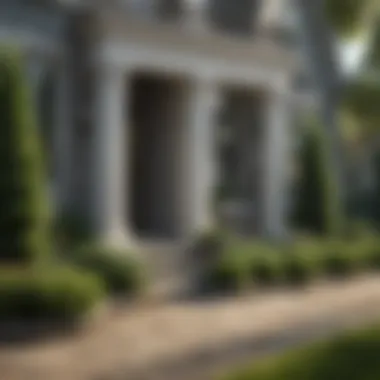
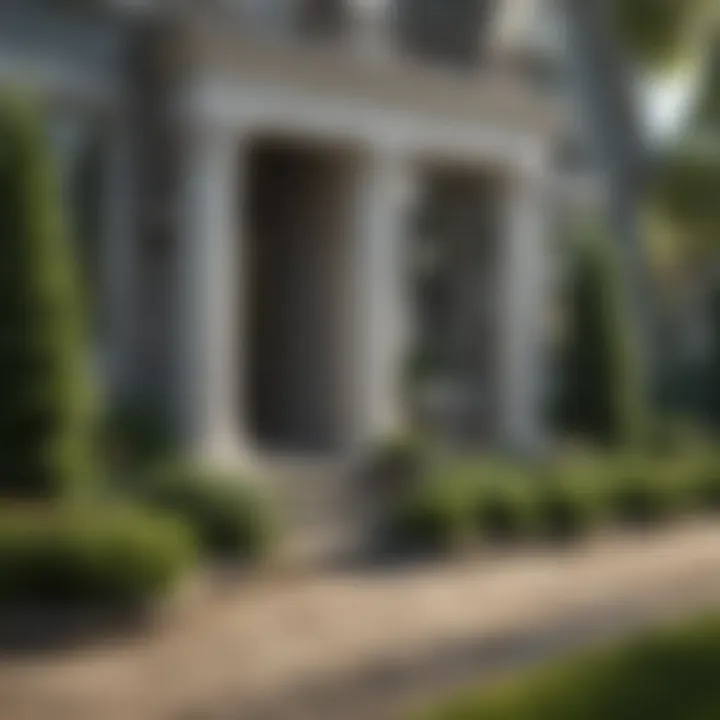
Intro
Front yard walls serve both functional and aesthetic roles in residential properties. Their presence enhances security while simultaneously contributing to the visual appeal of a home. This article will delve into the multifaceted aspects of front yard walls. We will explore materials, styles, and how they influence privacy and neighborhood dynamics.
Understanding the significance of front yard walls requires examining current trends in design, materials used, and the implications of legal regulations. As residential designs evolve, so too do the walls that accompany them. This exploration provides homeowners and design enthusiasts with insights into how front yard walls can elevate their property’s value and charm.
Design Inspiration
Designing a front yard wall involves more than just choosing a material. Current trends in residential design emphasize blending functionality with aesthetics, prioritizing personal taste while considering neighborhood styles.
Current Trends in Residential Design
The modern trend in landscaping leans towards incorporating natural elements into design. Front yard walls are no exception. Popular materials include:
- Brick: Timeless and sturdy, brick offers a traditional feel with many color options.
- Stone: Natural stone walls create a rustic yet elegant appearance.
- Wood: Trendy for those seeking a more organic look.
- Metal: For a modern and sleek design, corten steel is often favored.
- Glass: Used to create clear boundaries without obstructing views.
As homeowners seek personalization, combining these materials can produce unique styles that reflect individual tastes while enhancing property value.
Color Schemes and Palette Ideas
The color of a front yard wall can significantly impact its visual appeal. Neutral tones like beige or gray often blend well with various landscaping elements. Bold colors can highlight the wall itself and create a striking focal point. Here are some palette ideas:
- Earth Tones: Browns and greens can create a harmonious connection with surrounding nature.
- Monochrome: Using varying shades of one color can add depth and sophistication.
- Accent Colors: Bright hues can draw attention and showcase the owner’s personality.
"A well-designed front yard wall can influence the entire façade of a home and complement the landscape."
The choice of color also influences how the wall interacts with plants, lighting, and other outdoor features.
Functional Aspects
Beyond aesthetics, front yard walls provide crucial benefits. They act as barriers that enhance privacy and security, creating a safe space for outdoor activities. Moreover, they can reduce noise pollution from streets, benefiting the home environment. Each function adds to the wall’s overall significance in residential settings.
Additionally, understanding local zoning laws and regulations is essential when planning a front yard wall. This knowledge ensures compliance with setbacks and height restrictions, avoiding costly alterations or fines.
Maintaining a front yard wall involves regular inspections and care, particularly for materials exposed to weather. Homeowners should consider how each material reacts to their specific climate conditions.
In summary, front yard walls encompass a multitude of roles in residential design. Their function ranges from providing security to serving as a focal point. As we examine their contributions, it becomes clear that these walls are more than just borders—they are integral components of a home's character.
Prelims to Front Yard Walls
The concept of front yard walls is often underestimated in discussions related to residential design. These structures play a crucial role beyond mere aesthetics. They contribute to the overall functionality and character of a home. In today’s society, where privacy and security are increasingly prioritized, front yard walls emerge as significant assets for homeowners. Their presence can enhance the visual appeal of a property while also defining boundaries.
Definition and Importance
Front yard walls are typically decorative or functional barriers placed along the perimeter of a property’s front yard. They can range in height and material, from low decorative walls to tall, solid structures that add privacy and security. The importance of these walls cannot be overstated. They establish a physical boundary between public and private spaces, which can help in deterring unwanted intrusion. Additionally, they can enhance the property's curb appeal, making it more attractive to potential buyers.
"A well-designed front yard wall not only offers privacy but also contributes significantly to the property’s overall aesthetic value."
Front yard walls can also serve as a canvas for creative landscaping. Homeowners can integrate plants, lighting, and colors to complement the wall, transforming it into a design feature.
Historical Context
The use of walls in front yards has deep historical roots. In ancient times, walls served primarily as protective structures. They defined property boundaries and safeguarded homes against intruders or wildlife. In many cultures, the design of these walls was both cultural and contextual. For instance, in Mediterranean regions, stone walls were common. They reflected the natural resources available and were often decorated with intricate designs.
During the Victorian era, front yard walls evolved into symbols of social status. Higher walls conveyed a greater sense of privacy and prestige. The materials used also varied based on the homeowner's wealth and the common trends of the time. Today, while the primary purpose remains, the design and aesthetic have evolved significantly. This evolution reflects changing societal values concerning security, privacy, and community dynamics.
The historical perspective of front yard walls highlights their shifting roles, from defensive structures to aesthetic elements that shape neighborhood identity.
Functional Aspects
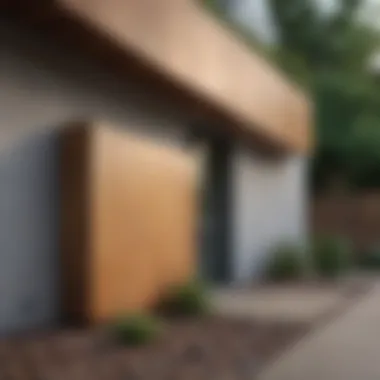
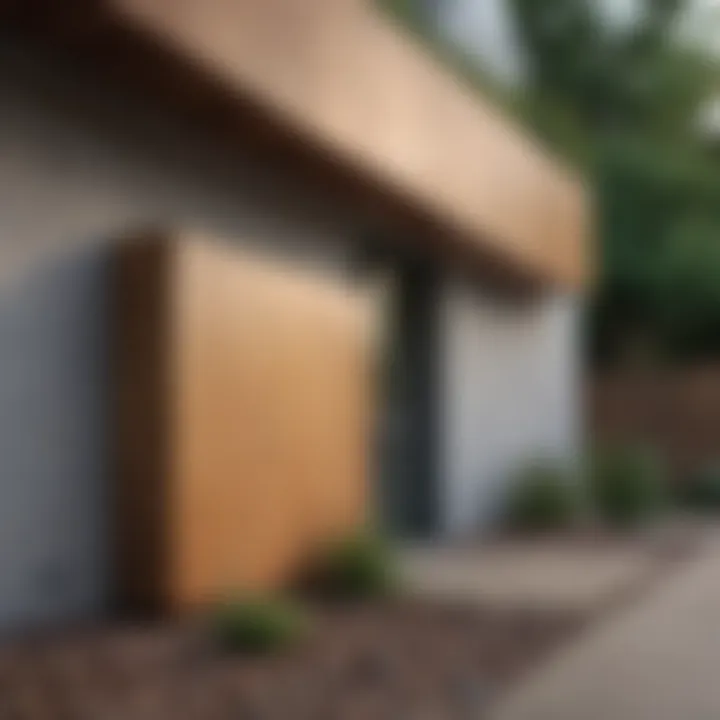
Understanding the functional aspects of front yard walls is crucial for a comprehensive evaluation of their role in residential design. These structures serve multiple purposes that cater to both the practical needs of homeowners and the overall aesthetic appeal of a property. Delving into these aspects provides valuable insight into how front yard walls can enhance comfort, privacy, security, and property definition.
Privacy Considerations
One of the primary functions of a front yard wall is to create a sense of privacy. Homeowners often seek solutions to shield their outdoor spaces from prying eyes. A well-placed wall can act as an effective barrier against the public view, granting residents the freedom to enjoy their front yard without feeling exposed. The height and thickness of the wall, along with its positioning, can be tailored to optimize privacy. Many opt for walls that are sufficiently tall to obscure views but not so high as to feel confining. This balance is essential as it can influence social interactions. For instance, a wall that permits visibility, while offering some cover, can enhance community engagement without sacrificing solitude.
Security Functions
Security is another significant aspect that front yard walls address. A robust wall can serve as a physical deterrent to trespassers and unwanted visitors. The mere presence of a substantial structure often has a psychological effect, signaling that the property is well protected. Additionally, walls can be designed with features such as gates or locking mechanisms that provide added safety. For homeowners living in neighborhoods with higher crime rates, incorporating a secure front yard wall is not only a preventative measure but also a peace-of-mind investment. Combining security with aesthetic elements, like lighting or landscaping, can further enhance both safety and curb appeal.
Boundary Definition
Establishing clear boundaries is a fundamental function of front yard walls. These structures delineate the property line, helping homeowners define their space in relation to adjacent properties. This can reduce disputes with neighbors regarding land ownership and usage. By marking boundaries visually, front yard walls create a sense of ownership and belonging. Various design elements, materials, and heights can be employed to achieve an inviting yet defined entrance to a residence. A well-designed wall can also foster a welcoming atmosphere while demarcating private from public spaces—enabling residents to enjoy their property without concern about encroachment from others.
The integration of functional aspects such as privacy, security, and boundary definition not only boosts the utility of front yard walls but also enriches the overall living experience by promoting tranquility and order.
Aesthetic Contributions
Front yard walls play a significant role in enhancing the visual appeal of residential properties. They do not only serve practical purposes, but they also contribute to the overall aesthetics of a home. A well-designed wall can harmonize with the surrounding environment, complement the architectural style of the house, and create a cohesive look in the neighborhood. Homeowners should consider the visual impact of these structures alongside their functional benefits.
Architectural Harmony
Architectural harmony is about how well a front yard wall complements the style of a house. The wall should reflect the characteristics of the home, whether modern, traditional, or eclectic. For example, a sleek, minimalist wall in concrete or glass fits well with contemporary designs. Alternatively, a classic brick or wrought iron fence can enhance the charm of a traditional or colonial home. When walls align with their surroundings, they create a balanced look that is visually pleasing.
Landscaping Synergy
Landscaping plays a critical role in the aesthetic appeal of front yard walls. The integration of green elements such as trees, shrubs, and flowers can soften the starkness of a wall, creating a more inviting atmosphere. A wall made of natural stone can blend seamlessly with floral beds and grass. On the other hand, walls that stand alone can appear dull or overwhelming, leading to a disconnect between the architecture and the landscape. Proper landscaping around a wall not only improves its attractiveness but also enriches the overall ambiance of the front yard.
Material Choices and Visual Impact
Material selection greatly influences the beauty of front yard walls. Here are some popular options:
Brick
Brick walls are durable and versatile. They bring a timeless quality to any home. The texture and color variations in bricks can enhance the wall's appearance and allow for creativity in design. Brick is also a popular choice because it withstands harsh weather conditions while maintaining its aesthetic appeal.
Stone
Stone adds a natural feel to a property. The unique patterns in stone can create a stunning visual effect. Natural stone walls bring a rustic charm, distinguishing properties from others in a neighborhood. However, they can be more expensive than other materials, which may limit their use.
Wood
Wooden walls provide warmth and a natural element to a front yard. They are customizable and can be painted or stained in various colors to suit personal preferences. Yet, wood requires more maintenance than other materials due to its susceptibility to rot and insect damage.
Metal
Metal walls, especially those made from wrought iron, offer a sleek and modern look. They are durable and often seen as a symbol of elegance. However, they might require occasional rust treatment depending on the metal type and environmental exposure.
Composite Materials
Composite materials combine different elements to create a wall that is both visually appealing and functional. These materials can mimic the look of wood or stone but often come with enhanced durability and lower maintenance requirements. They provide a modern solution for homeowners looking for an aesthetic without the fuss of traditional materials.
Design Styles
In the context of front yard walls, design styles play a crucial role in establishing the character and aesthetic of a property. The design style can significantly affect how a home sits within its environment, influences curb appeal, and sets the tone for visitor expectations. Homeowners should consider various factors when choosing a design style, including architectural compatibility, neighborhood trends, and personal preferences. Each design style offers unique benefits and considerations, allowing homeowners to tailor their front yard walls to their specific needs and tastes.
Contemporary Walls

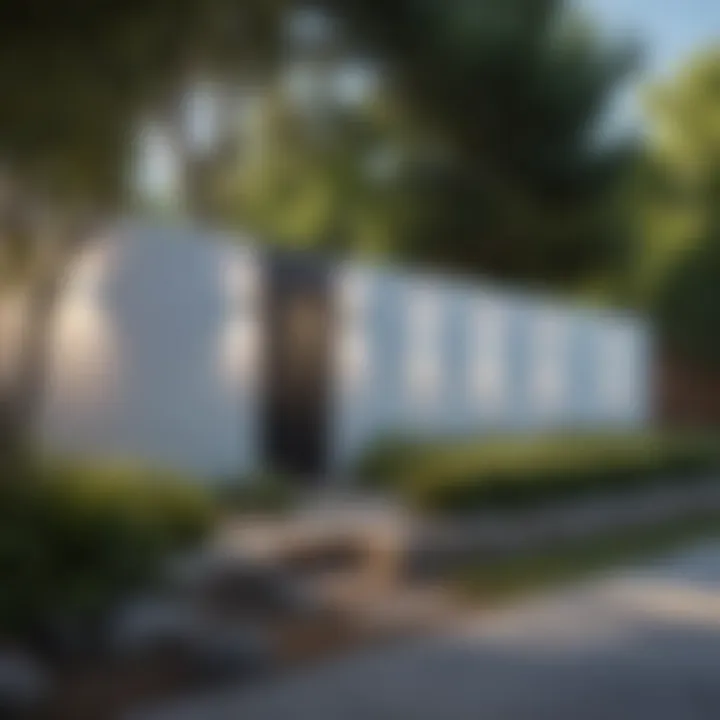
Contemporary walls reflect modern design principles. Featuring clean lines and minimalistic features, they enhance the overall sleekness of urban spaces. Common materials for contemporary walls include concrete, glass, and metal. These materials not only provide durability but also allow for creative expression, often seen in geometric shapes or layered textures.
Homeowners opting for contemporary walls should prioritize functionality alongside aesthetics. Incorporating materials like clear glass can offer a visually appealing transparency, creating the illusion of a more open space while maintaining some level of separation. Additionally, these walls often emphasize eco-friendly materials and practices, reflecting modern sensibilities regarding sustainability.
Traditional Walls
Traditional walls embody timeless design principles, often incorporating materials like brick, stone, or wood. These elements lend a sense of permanence to the property and resonate with classical architectural styles. Traditional walls often feature decorative tops or caps, giving them a refined appearance.
The choice of a traditional wall can benefit homeowners looking to instill warmth and familiarity into their designs. It can be especially appealing in older neighborhoods or areas with historical significance. These walls often foster a sense of community, as they are visually cohesive with others in the vicinity. While traditional walls may require more maintenance over time, their enduring qualities often outweigh those considerations.
Cottage and Garden Styles
Cottage and garden styles provide an inviting and whimsical aesthetic. These walls typically utilize soft curves and organic shapes, often integrating nature and greenery into their designs. Materials like wood, wrought iron, and lightweight stone are common, promoting a quaint and rustic feel.
These designs are particularly suited for homeowners who value a strong connection with nature. For example, climbing plants can be trained to grow along garden walls, creating a seamless blend of architecture and landscape. Such styles also create a relaxed environment, ideal for gardens and open-air settings. Homeowners may also choose to incorporate ornamental features, such as trellises or decorative gates, further enhancing the charm of their outdoor spaces.
In summary, when selecting a design style for front yard walls, homeowners should carefully consider how each choice reflects their values, enhances their property, and engages with the surrounding neighborhood.
Legal and Regulatory Considerations
When it comes to constructing a front yard wall, understanding the relevant legal and regulatory considerations is crucial for homeowners and designers alike. Not only do these factors determine the feasibility of your wall project, but they also guide compliance with local standards. Addressing zoning laws and building codes can prevent potential disputes and ensure that the project aligns with neighborhood aesthetics and safety requirements. Ignoring these aspects can lead to fines, mandatory modifications, or even removal of the wall, which can be both costly and time-consuming.
Zoning Laws
Zoning laws are a set of regulations that dictate how property within specific geographic zones can be used. They often include stipulations related to the height, placement, and appearance of structures such as front yard walls. These rules can significantly impact your design choices, so it is essential to review the zoning regulations that pertain to your area before embarking on any construction.
Some common zoning considerations include:
- Height Restrictions: Many jurisdictions specify maximum heights for front yard walls to maintain uniformity within neighborhoods. This limitation helps to preserve sightlines and does not impede visibility for vehicles and pedestrians.
- Setback Requirements: Zoning laws may require a specific distance between the wall and the property line. This distance ensures that walls do not encroach on public spaces or adjacent properties.
- Design Guidelines: Certain zones may have architectural style requirements to ensure consistency in aesthetics. Compliance with these guidelines can improve the likelihood of acceptance by local authorities.
Understanding these zoning laws is vital, as they are designed to promote harmonious neighborhood development while also maintaining property values.
Building Codes
Building codes encompass safety and structural regulations that ensure that constructed walls meet specific standards. These codes can cover a wide range of elements, including material specifications, structural integrity, and installation methods. Familiarizing yourself with the applicable building codes will help you create a robust privacy or boundary wall that can withstand environmental factors.
Key areas of building codes include:
- Material Standards: There may be specific guidelines regarding which materials are acceptable for use in front yard walls. This consideration often ties into local climate conditions and the need for durability.
- Structural Support: Building codes often require walls to have adequate foundations and support to prevent damage during high winds or earthquakes. These measures ensure safety and long-term functionality.
- Permitting Process: Many areas require a permit for any new wall construction or significant modifications to existing structures. Securing this permit typically involves submitting plans for review to local authorities.
Always consult your local building department before starting any project to ensure you comply with all legal and regulatory requirements.
Maintenance and Durability
Taking care of front yard walls involves understanding how various factors affect their longevity and appearance. Maintenance and durability are intertwined concepts that significantly influence the value and appeal of any residential property. Homeowners often overlook these aspects until issues arise, leading to costly repairs and diminished aesthetics. Addressing maintenance concerns proactively ensures that the wall remains in good condition over time. The type of materials selected for the wall also plays a crucial role in determining how much upkeep it will require.
Moreover, regular maintenance not only extends the life of the wall but also enhances its visual appeal. A well-maintained wall contributes to a home’s curb appeal and overall value. Therefore, it is essential for homeowners to understand both common maintenance issues and the durability of the materials involved.
Common Maintenance Issues
Every type of material used in front yard walls presents unique maintenance challenges. Homeowners should be aware of these potential issues to prevent long-term damage. Here are some common maintenance problems:
- Cracks and Chips: These can develop over time due to weather conditions or settling of the ground. Regular inspections will help identify early signs of damage.
- Moss and Algae Growth: Particularly in damp climates, organic growth can detract from the wall's appearance and promote deterioration. Regular cleaning can mitigate this issue.
- Paint Peeling or Fading: If the wall has been painted, it requires periodic repainting to maintain its appearance and protect the material underneath.
- Structural Integrity: Walls can suffer from issues like leaning or bulging, especially if built on unstable ground. Monitoring for these signs is vital.
To combat these issues, homeowners should schedule regular maintenance checks. Repairing minor damages promptly can prevent escalation into larger, more costly problems.
Durability of Materials
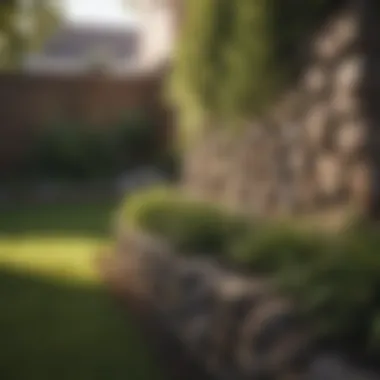
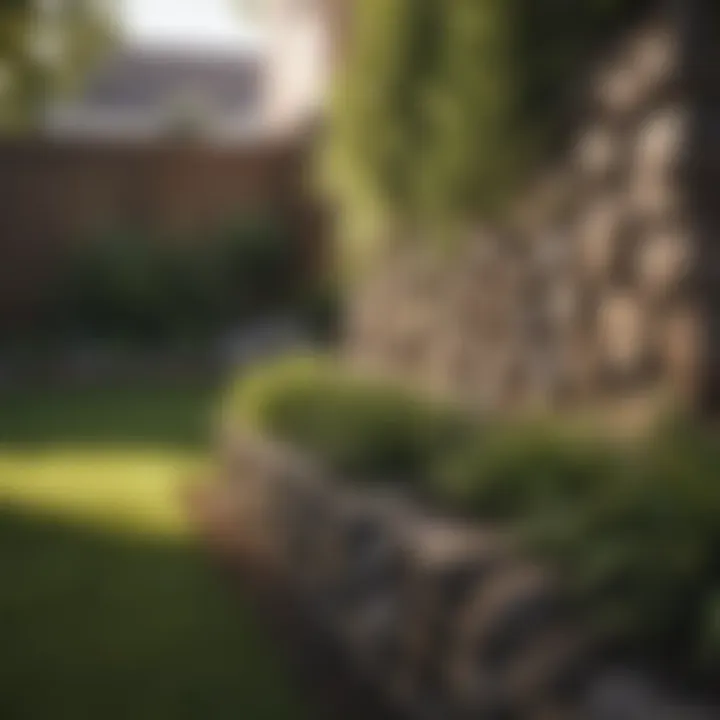
The choice of material fundamentally influences the durability of front yard walls. Various materials come with their own advantages and longevity considerations. Here are some common materials used:
- Brick: Known for its strength and classic appeal, bricks are durable and can last for decades, but they may require repointing and cleaning periodically.
- Stone: Similar to brick, stone walls are highly durable. However, they may be more expensive and can require sealing to prevent moisture intrusion.
- Wood: While wood gives a natural look, it is more susceptible to rot and pests. Treatments and regular staining are essential for preservation.
- Metal: Options like wrought iron or aluminum provide long-lasting solutions. However, they can be prone to rust without proper treatment.
- Composite Materials: These can mimic the look of wood or stone while offering durability and lower maintenance needs. They resist rotting, fading, and warping.
When selecting materials for construction, it is essential to balance aesthetic desires with the practical implications for maintenance and future durability. A well-chosen material can lead to a front yard wall that not only looks good but also stands the test of time.
The Role of Front Yard Walls in Neighborhood Dynamics
Front yard walls play a significant role in shaping the dynamics of neighborhoods. They do not only serve as a physical barrier but also act as a means of communication between homes. This section will outline the importance of front yard walls in fostering community interactions and their cultural significance within residential areas.
Community Interactions
Front yard walls can influence the nature of relationships between neighbors. They establish a boundary, yet they also foster a sense of connection. For example, low walls or picket fences often promote interaction. Neighbors may chat over the wall while gardening or discussing local events. Conversely, tall walls provide privacy, which might limit interactions to occasional greetings.
Considerable aspects include:
- Visibility: Low walls enable visibility into a yard, allowing for social interactions without invading personal space.
- Design: The aesthetics of a wall may attract friendly interactions. Decorative elements can invite curiosity and conversation.
- Community Identity: Walls may reflect the character of a neighborhood. A common style of fencing or brick wall can provide a sense of unity.
These dynamics can extend the network of support among residents. Events like block parties or neighborhood watch programs are more accessible when relationships are more robust, fostered through shared spaces.
"The way communities interact can be profoundly influenced by the presence and style of front yard walls. They can either foster or limit the connection between neighbors."
Cultural Significance
Culturally, front yard walls can symbolize values dear to a specific community. They can reflect historical values concerning privacy and security or ideas about openness and transparency. In some cultures, walls are adorned with art or decorations that convey messages about family heritage or beliefs.
Key points relating to their cultural significance are:
- Expressive Canvas: Some residents use walls for personal expression, painting murals or attaching decorative elements that tell a story.
- Traditions: In certain cultures, walls are an essential part of the property, carrying traditions related to boundaries, hospitality, or security.
- Neighborhood Character: The style and construction of walls can reveal socio-economic status and aspirations among residents, influencing perceptions within the community.
Overall, front yard walls contribute to how neighborhoods evolve and interact. They embody shared experiences, cultural values, and the balance between individual privacy and community engagement.
Culmination and Future Directions
The concept of front yard walls encapsulates a unique blend of functionality, design, and community interaction. As we reflect on the multifaceted roles these structures play, it becomes clear that their significance extends beyond aesthetics and into the realms of privacy and security. This exploration of front yard walls serves as a reminder that thoughtful design can enhance not only the individual property but also the neighborhood environment.
Through this article, we have highlighted how front yard walls function as boundaries, providing a sense of personal space in an increasingly connected world. Many homeowners choose to employ these walls for their privacy benefits. They transform a front yard into a secluded retreat, mitigating external distractions and allowing for more intimate outdoor experiences.
Another key insight emerges from understanding the aesthetic contributions of front yard walls. Their design choices can significantly impact the overall appeal of a property. A well-chosen wall type acts as an extension of architectural style, harmonizing with the home while enhancing its visual presence in the neighborhood.
Furthermore, the importance of discussing regulations cannot be overlooked. Zoning laws and building codes can guide homeowners in their decisions, ensuring compliance and promoting sustainability through responsible building practices. Understanding these frameworks can prevent future legal issues and enhance community relations.
As we look to the future, it becomes essential to consider the evolving trends in design and materials for front yard walls. Homeowners are increasingly drawn to sustainable options that not only reduce environmental impacts but also provide unique aesthetics. For instance, eco-friendly materials are now popular choices that align well with modern design sensibilities. Additionally, the incorporation of technology, such as integrated lighting and security features, is changing how these structures are perceived and utilized.
Looking ahead, the role of front yard walls is likely to adapt with shifting societal norms and environmental considerations. Continued research into sustainable materials and designs that promote inclusivity can lead to innovative solutions, fostering community connections while respecting individual privacy.
"A well-designed front yard wall is more than just a boundary; it reflects personal values, community standards, and the evolving dynamics of residential living."
In summary, front yard walls encapsulate a blend of aesthetic, functional, and regulatory factors that contribute to their relevance in modern residential design. As trends continue to evolve, so too will the significance of these structures, offering new opportunities for homeowners to enhance the beauty and functionality of their outdoor spaces.
Summarizing Key Insights
In summary, the exploration of front yard walls reveals several key insights:
- Privacy and Security: They serve as important barriers, creating a sense of safety and personal space.
- Aesthetic Value: The design of front yard walls contributes significantly to the overall visual appeal of a property.
- Community Dynamics: These walls can influence neighborhood interactions and establish boundaries that affect social connectivity.
- Regulatory Awareness: Being informed about zoning laws and building codes is crucial for successful implementation.
Trends in Front Yard Wall Design
Observing current trends in front yard wall design offers a glimpse into the future of residential landscaping. Some notable trends include:
- Sustainable Materials: The shift towards eco-friendly options is gaining traction. Homeowners are more conscious of their environmental impact, prompting a move to recycled or reclaimed materials.
- Modern Minimalism: Simple and clean lines characterize contemporary wall designs. This style favors understated elegance, often using materials like concrete and glass.
- Mixed Materials: Combining different materials in a single wall design creates visual interest and complexity, blending texture and colors.
- Functional Elements: Features that combine utility with design, like built-in seating or planters, are becoming more popular. This integration enhances both aesthetics and practicality.
- Technology Integration: Smart walls equipped with lighting, sensors, and security systems are redefining traditional boundaries. This trend emphasizes safety and convenience in residential spaces.
These trends indicate a shift toward more thoughtful, innovative, and functional front yard wall designs, which cater to the needs of modern homeowners while respecting environmental concerns.



